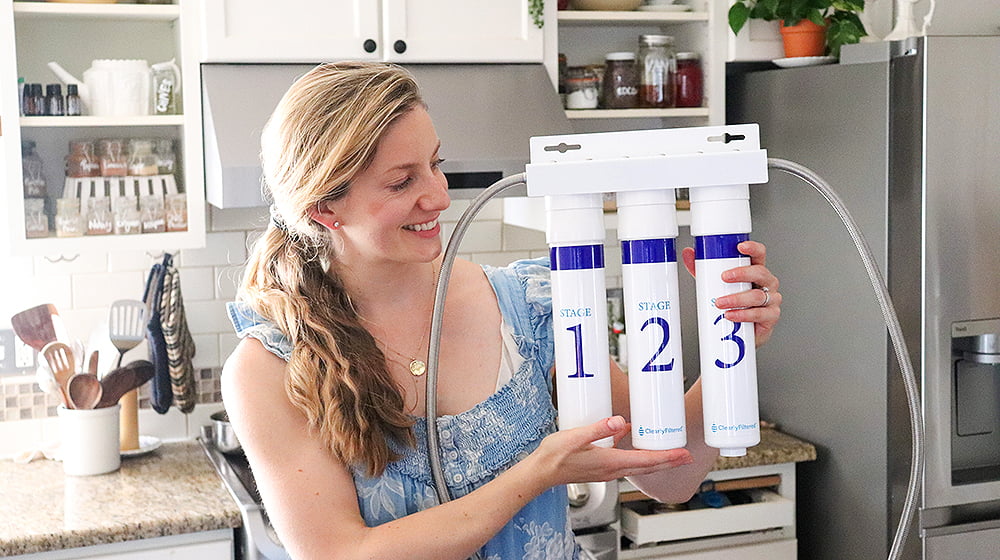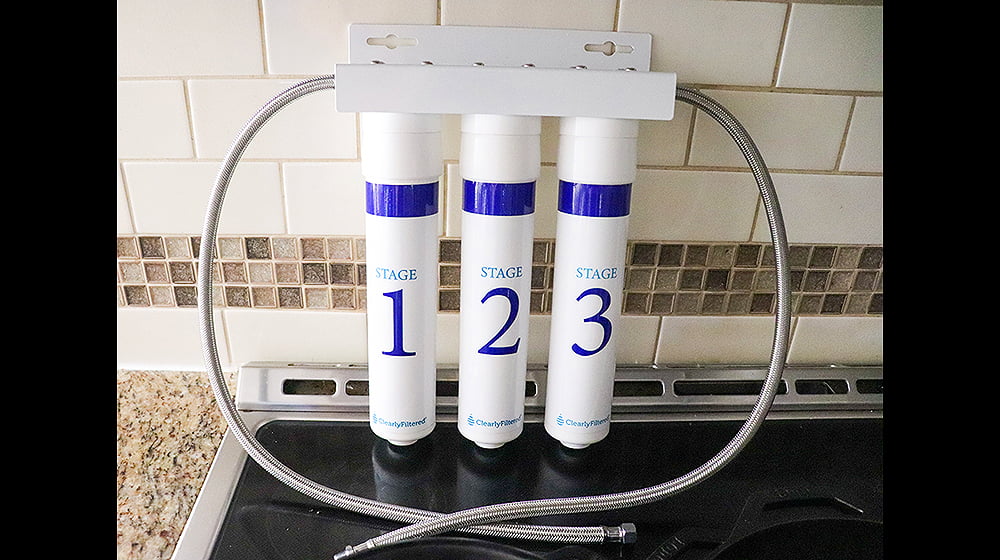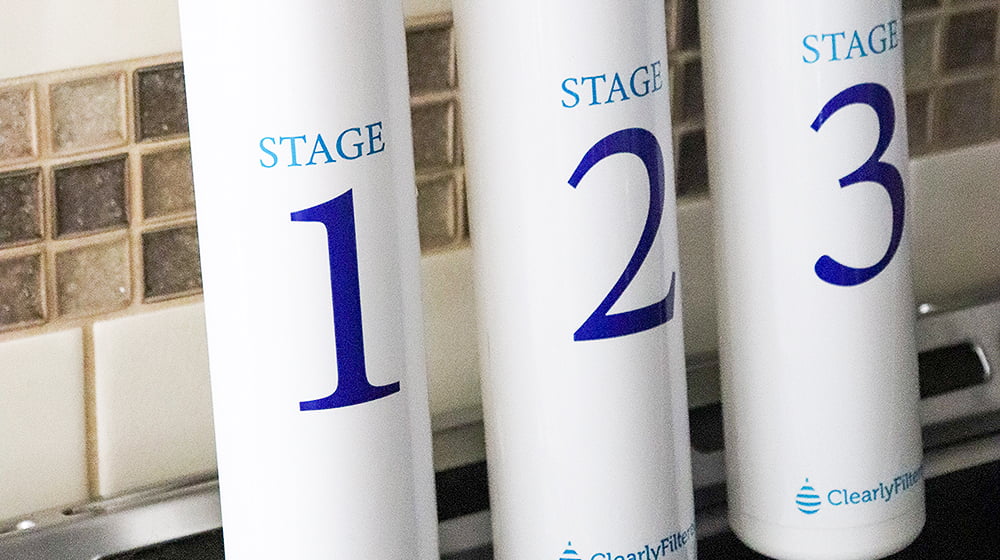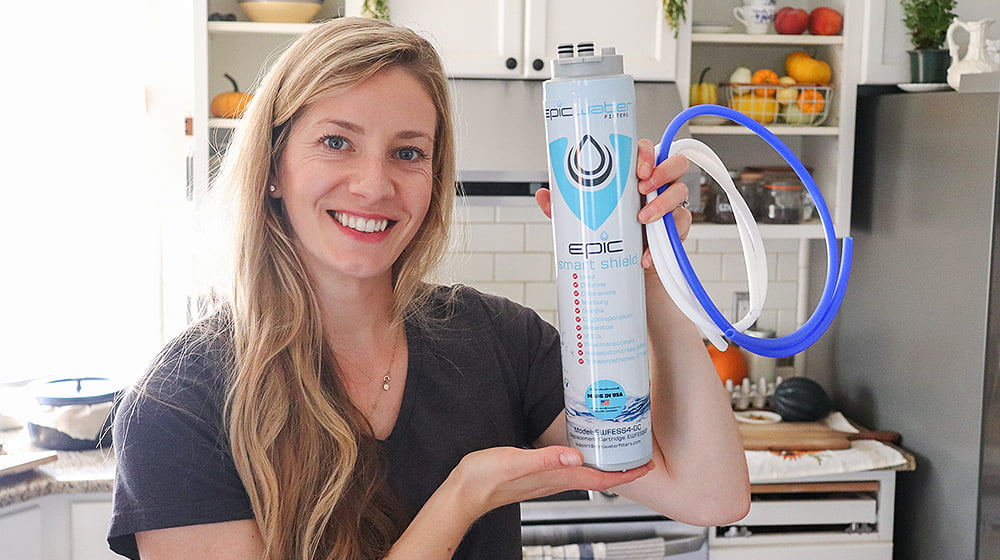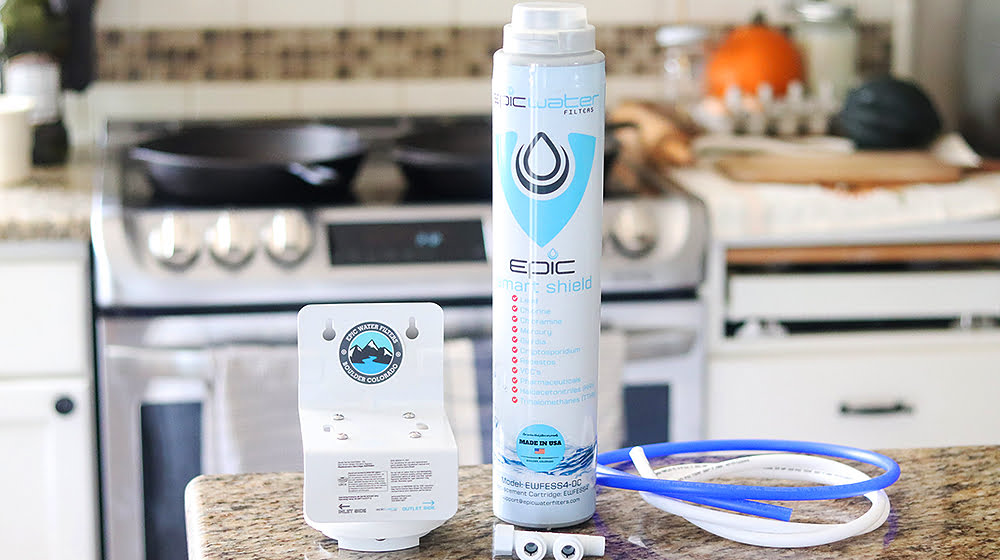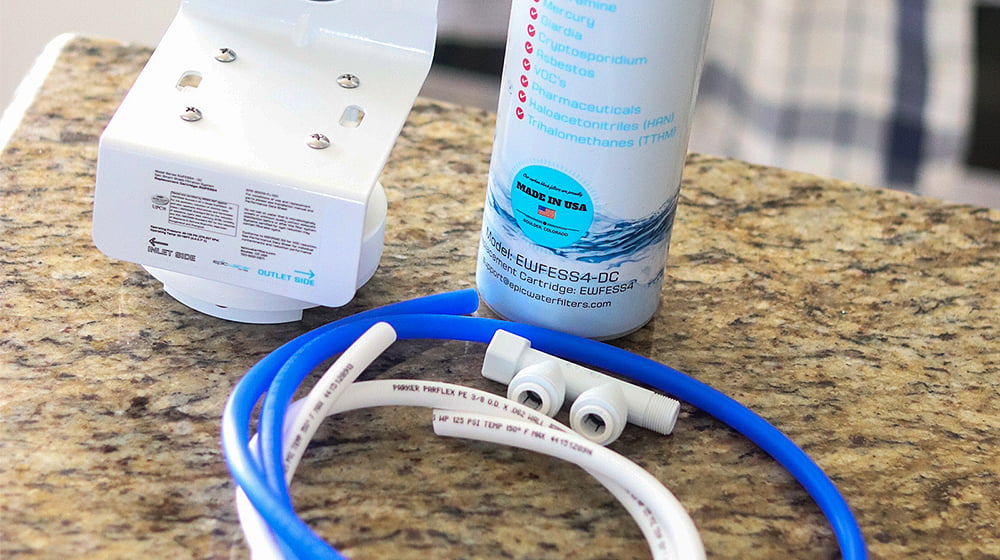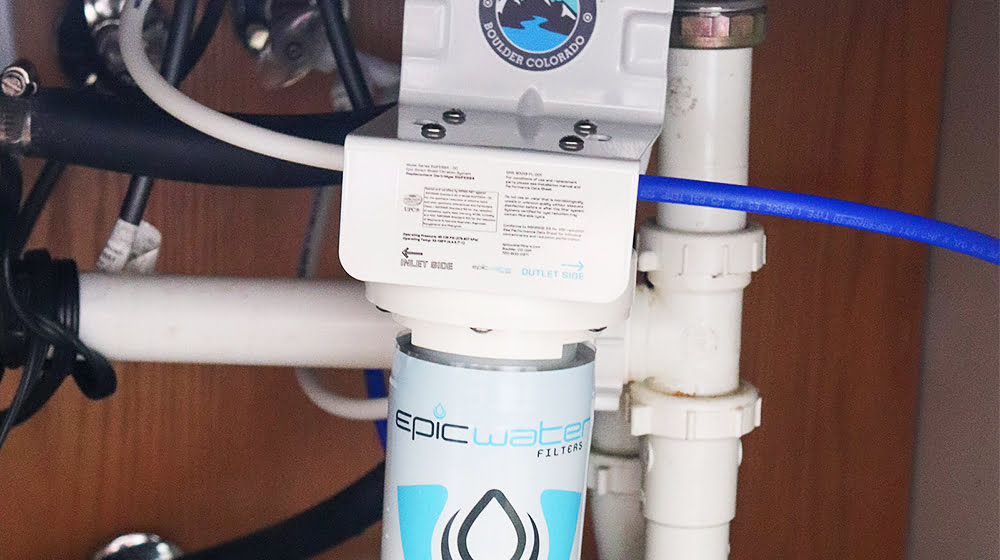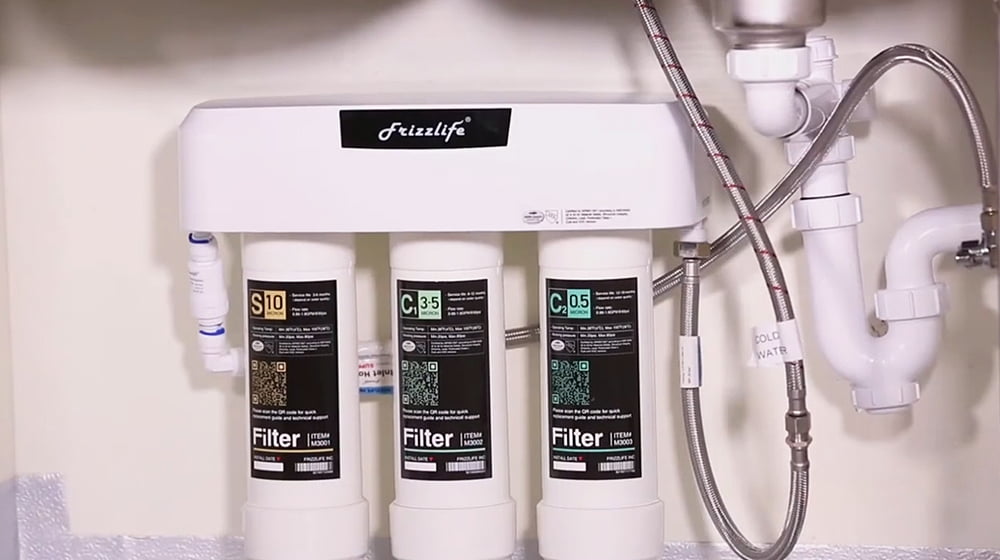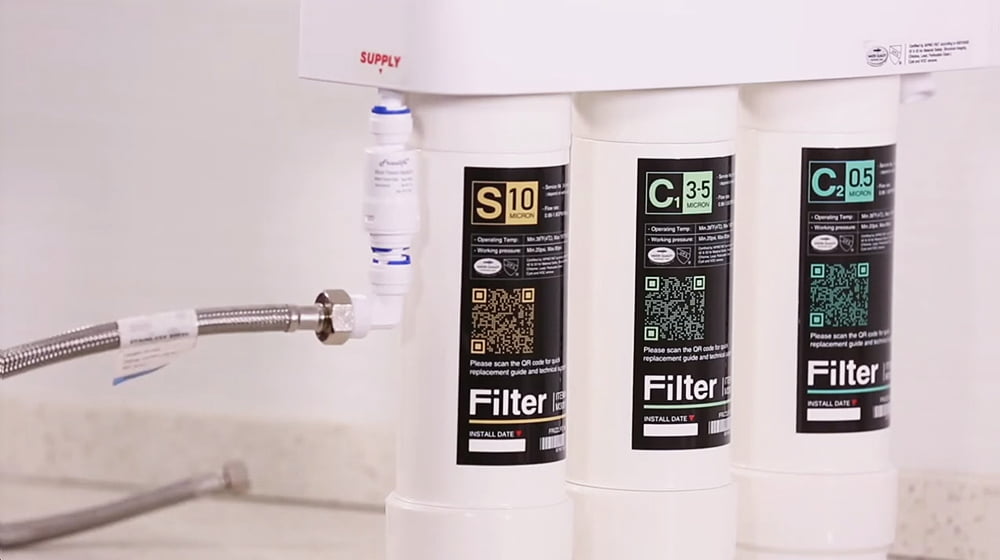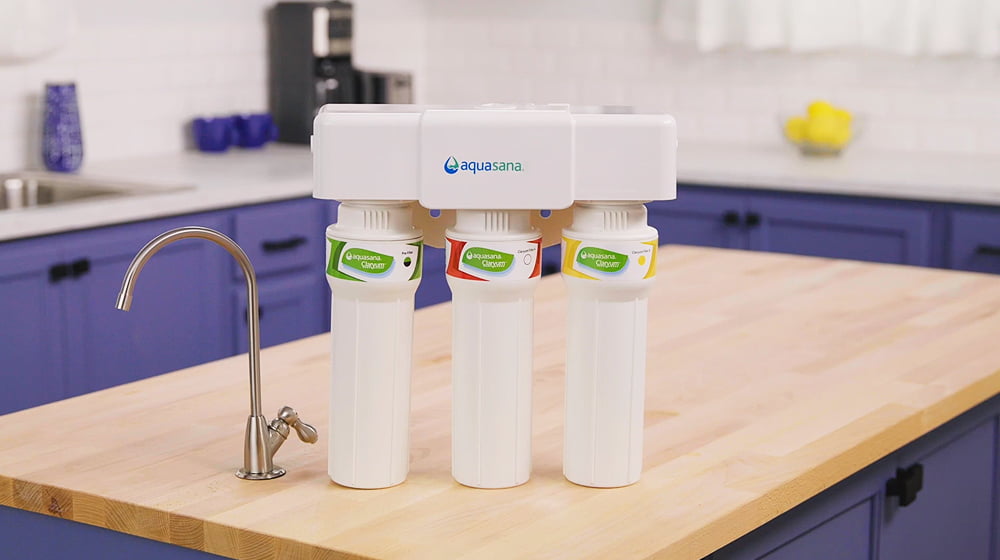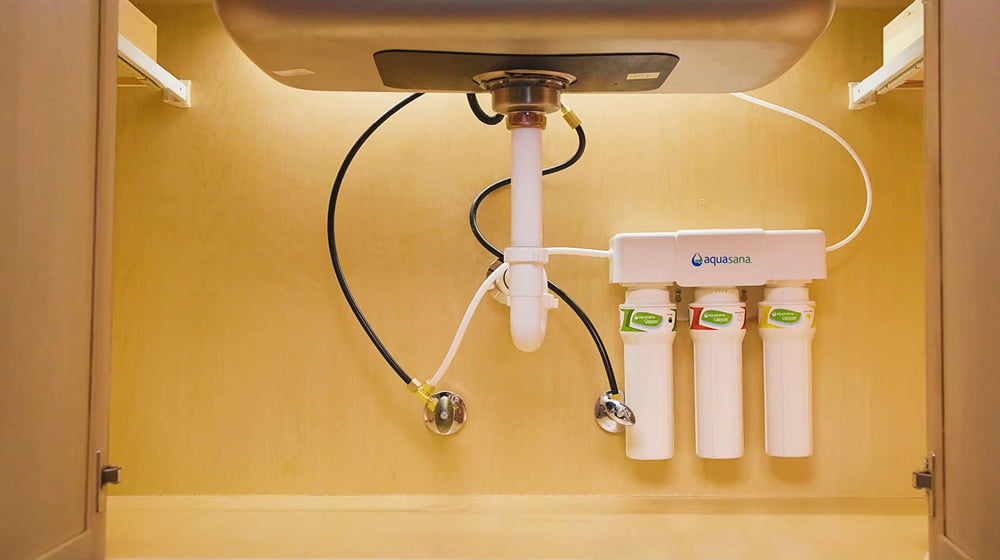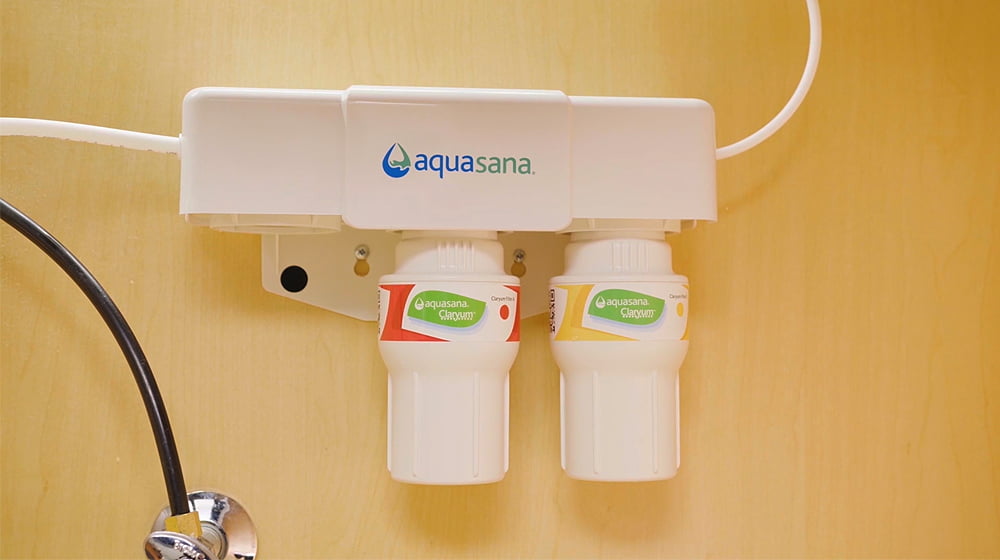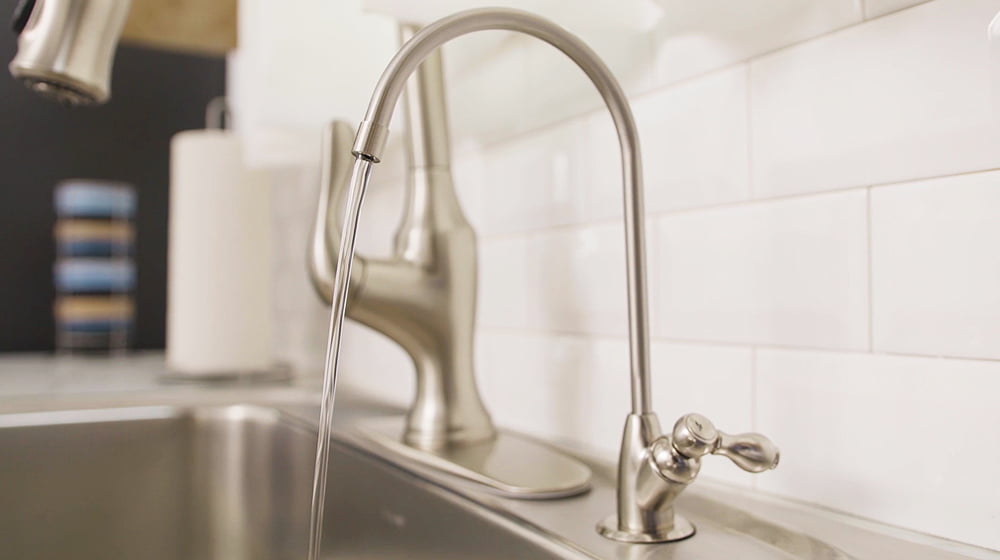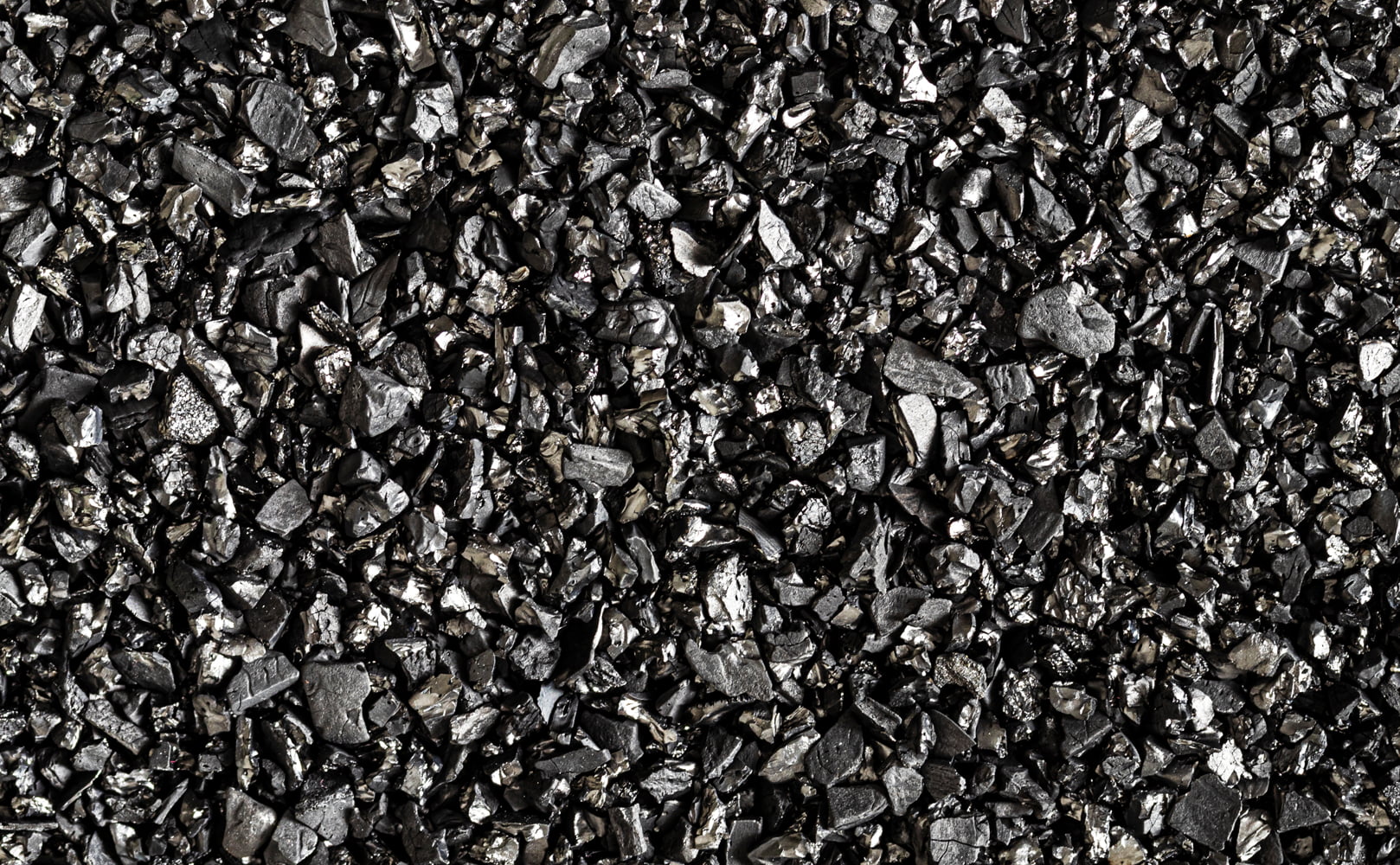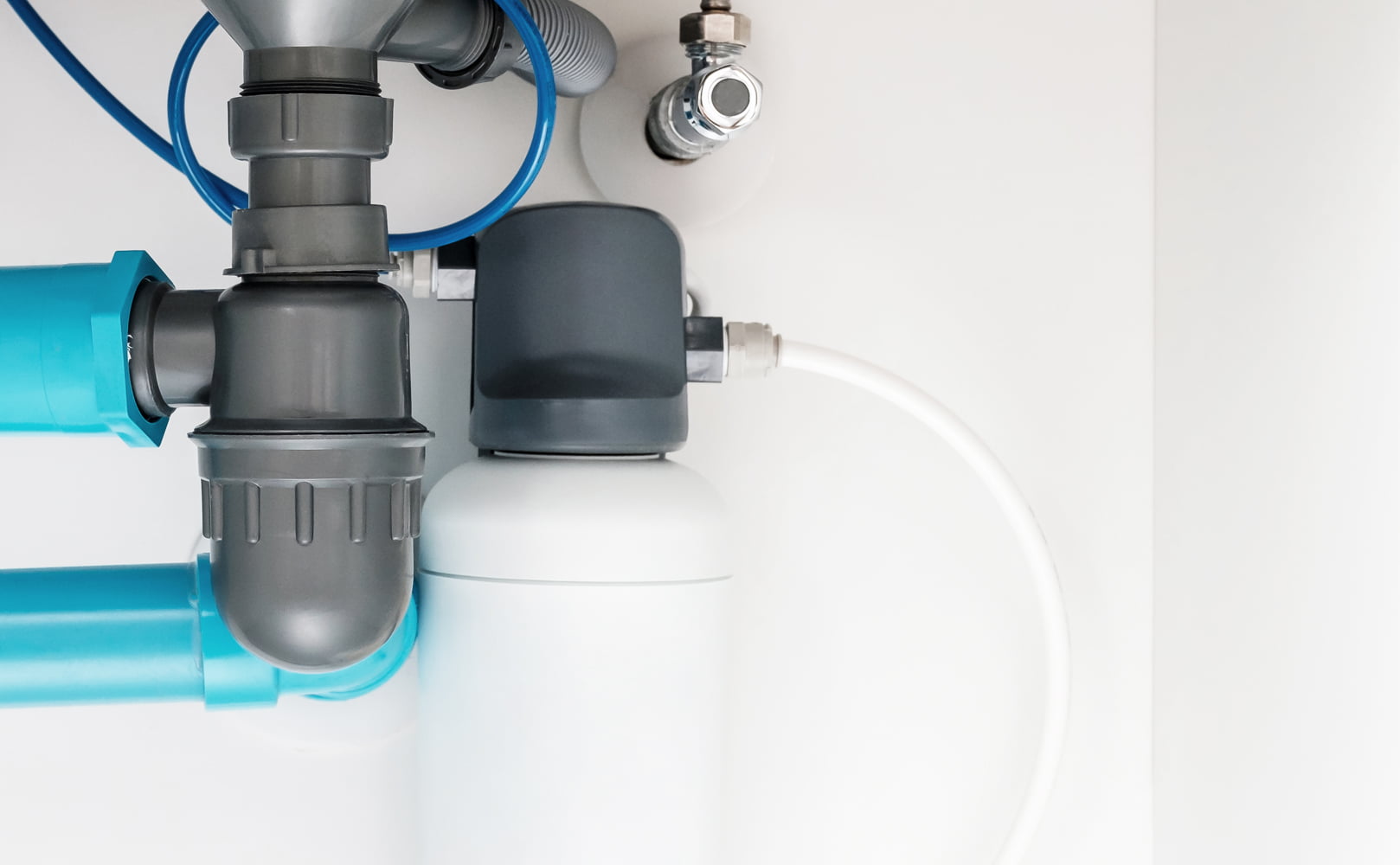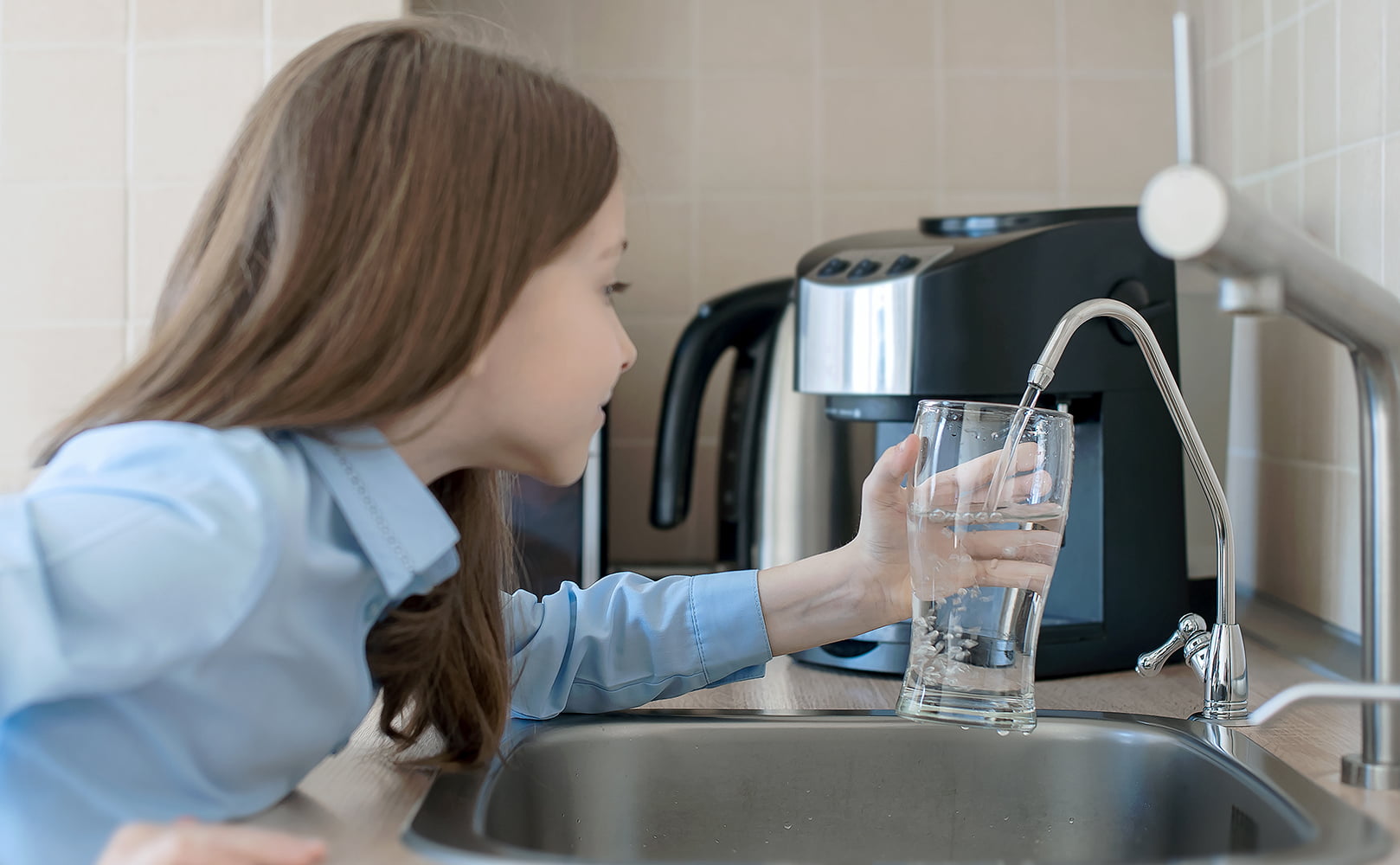5 Best Under Sink Carbon Water Filters (*Update 2024)
Written by: Gene Fitzgerald // Expert Fact-Checking: Buddhini Dolapihilla, MBSS // Last Updated: Jan 31, 2024
This page may contain affiliate links. If you buy a product or service through such a link we earn a commission at no extra cost to you. Learn more.
Top Pick: What’s the Best Under Sink Carbon Water Filter?
The best under sink carbon water filter in 2024 is the Clearly Filtered 3-Stage, because it removes 200+ water contaminants (tested against NSF standards 42, 53, 401), it is effortless to install and maintain, it is durable and backed by a 1-month satisfaction guarantee and lifetime warranty, and it has a high filter capacity of 2,000 gallons.
Finding the perfect water filter for your needs isn’t easy with so many options available. However, when it comes to under sink carbon water filters, we’ve done the hard work for you. Our team has evaluated over 25 of the top systems in the market, dedicating countless hours to research, review, testing, and comparison.
The end result is this buying guide which is being updated with new information whenever necessary. Time to find you the best under sink carbon water filter!
No Time to Read? Check Our List of the Best Under Sink Carbon Water Filters!
| Product | Details | |
|---|---|---|
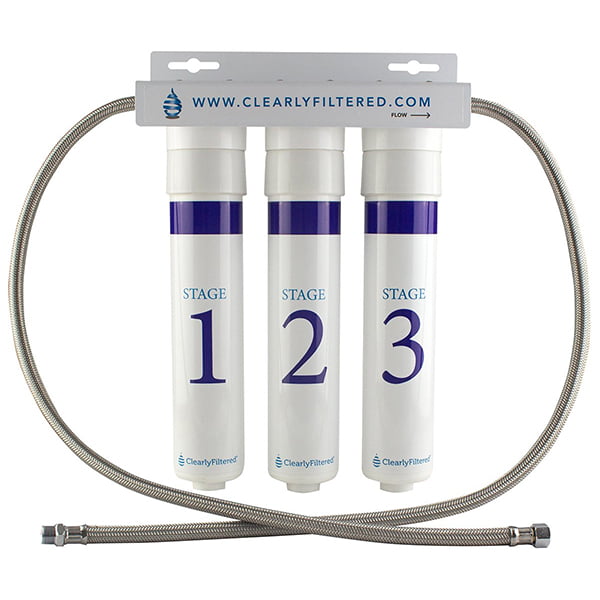 Best Overall: Clearly Filtered 3-Stage |
Overall Rating: 5.0/5.0 ⓘRatings based on effectiveness of filtration, NSF testing/certification, filter life, price and annual cost, warranties, first-hand experience, user ratings, and other factors.
Get 10% Off! Use Code: |
Price: $$$ Flow Rates: Not Specified Filter Life: 2,000 Gallons NSF: 42, 53, 401 Annual Cost: $440 Read Review: Click Alexa’s Video Review: Click |
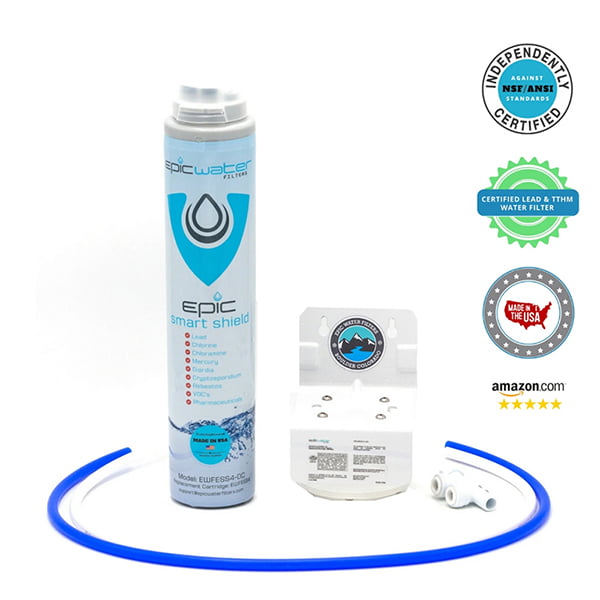 Best for Pure Carbon Filtration: Epic Smart Shield |
Overall Rating: 4.5/5.0 ⓘRatings based on effectiveness of filtration, NSF testing/certification, filter life, price and annual cost, warranties, first-hand experience, user ratings, and other factors.
Get 20% Off! Use Code: |
Price: $ Flow Rates: 1.25 Gallons Per Minute Filter Life: 651 Gallons NSF: 42, 53, 401 Annual Cost: $115 Read Review: Click Alexa’s Video Review: Click |
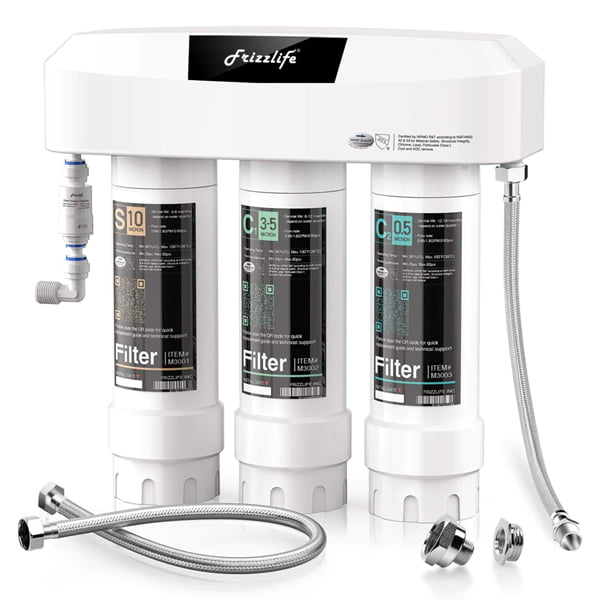 Best Budget Pick: Frizzlife SK99 |
Overall Rating: 4.0/5.0 ⓘRatings based on effectiveness of filtration, NSF testing/certification, filter life, price and annual cost, warranties, first-hand experience, user ratings, and other factors.
|
Price: $ Flow Rates: 2 Gallons Per Minute Filter Life: 3-18 Months NSF: 42, 53 Annual Cost: ~$50-100 Read Review: Click |
Under Sink Carbon Water Filter Reviews
Our Top Picks
- Clearly Filtered 3-Stage – Our Top Pick
- Epic Smart Shield – Best for Pure Carbon Filtration
- Frizzlife SK99 – Best for Low Budgets
- Culligan US-EZ 1, 3 & 4 – Best for Customization
- Aquasana AQ5300+ Max Flow – Best for NSF-Certified Filtration
1. Best Overall: Clearly Filtered Under-the-Sink Water Filter System
In our opinion, the best under sink carbon water filter in 2024 is the Clearly Filtered 3-Stage. That’s because it targets many different types of water contaminants for broad-based removal – lab testing shows outstanding reduction rates of more than 200 substances. Plus, there are many cool extras!

Clearly Filtered Under-the-Sink Water Filter System |
|
| Price: | $$$ |
| Water Flow Rate: | Not Specified |
| Filter Capacity: | 2,000 gal |
| NSF Standards: | 42, 53, 401 |
| Annually: | $440 |
|
Overall Rating: 5.0/5.0 ⓘRatings based on effectiveness of filtration, NSF testing/certification, filter life, price and annual cost, warranties, first-hand experience, user ratings, and other factors.
Get 10% Off! Use Code: |
|
Alexa’s Video Review
As part of the BOS team, Alexa has installed and tested the Clearly Filtered Under-the-Sink Water Filter System in her own home and with her own hands. She has used the system for several weeks to gather genuine first-hand experience. And most importantly, Alexa has documented the entire process, including her findings and personal opinion, in the video below:
Other Specs
- Model: CF-UTSF
- Last Price: $550.00
- Filter Media/Process: Coconut Carbon Pre-Filter, Proprietary Blends
- Filter Stages: 3
- WxHxD: 15″x15.4″x3.1″
- Weight: 6.9 lbs
- Water Temperature: 38-85 °F
- Fitting: 3/8″
- Warranty: Lifetime (Limited)
Key Features & Pros
- Made in the USA.
- The three-stage filter process offers thorough filtration.
- Stage 1: Coconut shell carbon reduces sediment as well as chlorine, chloramine, foul taste and odor, turbidity, VOCs, and many other common chemicals. This stage is manufactured in the USA.
- Stage 2: Proprietary filter media blend removes or reduces heavy metals including lead and chromium 6, pesticides, radiological contaminants, PFAS, and more. This stage is also made in the USA.
- Stage 3: The final filter stage is also a propriety blend and will remove both arsenic and fluoride.
- The system is tested and partially certified against NSF standards 42, 53, and 401.
- The CF is tested against over 230 contaminants, making it one of the most thoroughly tested systems available.
- Essential minerals aren’t stripped away by the filtration process, so your drinking water will contribute to your daily mineral intake.
- Inline design makes the under sink carbon filter easy to install and work with your existing kitchen faucet.
- The non-permanent installation makes the system ideal for renters – no drilling or cutting is required.
- Installation takes just 10 minutes and doesn’t require any special tools.
- Modular filter design makes changing filters easy without the need for tools.
- 2,000-gallon or one-year filter capacity is on the higher side.
- Clearly offers the system with a limited lifetime warranty as well as a 30-day money-back satisfaction guarantee.
- The manufacturer’s customer service is knowledgeable and responsive.
Cons
- Many users experienced a 25 to 35 percent reduction in water pressure.
- Due to the higher cost of US manufacturing and testing, the system costs significantly more than the competition.
- Filter cartridge replacements aren’t cheap either. Even factoring in the 10% discount for when you subscribe to autoship, you’re still looking at $396 per year.
Our Rating
- Filtration Performance: 5.0/5.0
- Filter Life: 5.0/5.0
- Price: 4.0/5.0
- Maintenance Cost: 4.5/5.0
- Overall: 5.0/5.0
Best for
The Clearly Filtered 3-Stage Under-the-Sink Water Filter System is the best overall under sink carbon water filter for removing a wide array of contaminant types.
→ Read Our Full Clearly Filtered Under Sink Filter Review
2. Best for Pure Carbon Filtration: Epic Smart Shield Under Sink Water Filter
The Clearly Filtered from above combines activated carbon with several other types of filter media. Thus, if you want nothing but pure carbon filtration you need to go with something else. We recommend the Epic Smart Shield. It uses a single and very powerful activated carbon filter block.

Epic Smart Shield Under Sink Water Filter |
|
| Price: | $ |
| Water Flow Rate: | 1.25 gpm |
| Filter Capacity: | 651 gal |
| NSF Standards: | 42, 53, 401 |
| Annually: | $115 |
|
Overall Rating: 4.5/5.0 ⓘRatings based on effectiveness of filtration, NSF testing/certification, filter life, price and annual cost, warranties, first-hand experience, user ratings, and other factors.
Get 20% Off! Use Code: |
|
Alexa’s Video Review
Being an integral member of the BOS team, Alexa has ordered and tested the Epic Smart Shield Under Sink Water Filter at home. She shares her hands-on experience of installing and using the system in the video below:
Other Specs
- Model: Epic Smart Shield
- Last Price: $135
- Filter Media/Process: Carbon Block
- WxHxD: 4.25″x19.75″x4.5″
- Water Temperature: 33-100 °F
- Water Pressure: 40-120 psi
- Fitting: 3/8″ NPT
- Warranty: Lifetime
Key Features & Pros
- Great budget pick!
- Manufactured in the USA.
- Designed to operate both with municipal and well supplied water.
- If your water contains high levels of sediment, then installing an additional 5-micron pre-filter is recommended by the manufacturer. The same goes for water supplied by a well – which tends to contain higher levels of sediment.
- The system uses a coconut activated carbon block to remove the following contaminants: Chlorine (95.5%), chloramine (95.5%), foul tastes and odors, cysts (>99.99%), VOCs (99.6%), asbestos (>99%), lead (>99.3%), mercury (>96.6%), turbidity, MTBE, BPA, Ibuprofen, Estrone, Phenytoin Naproxen, Phenytoin, Nonyl phenol, microplastics, PFOA/PFOS, E. Coli, Pseudomonas Aeruginosa, and even radiological contaminants among other stuff.
- All according to NSF standards 42, 53, and 401.
- One of the simplest systems to install – installation can be completed in just 20 minutes or so and doesn’t require any special tools.
- Connector hoses, feed water adapter, and quick-connect fittings make the installation essentially foolproof.
- The inline design makes installation straightforward. It uses your sink’s existing faucet and cold-water supply line, so there’s no need to drill holes in the sink or countertop.
- An optional dedicated chrome faucet kit allows you to install the Epic Smart Shield with a separate faucet should you wish.
- The filter capacity is 650 gallons (or approximately 12 months), and filter replacement costs total just $115 annually.
- Signing up for Epic’s auto-ship will save you 20% on future filter replacement costs.
- Epic is committed to recycling – and will send you a brand new replacement filter cartridge at no cost when you send in 3 used ones.
- Lifetime warranty on the system and money-back satisfaction guarantee.
- Responsive and knowledgeable customer service.
Cons
- The flow rate is just 1.25 gallons per minute. This is on the lower side, and as a result, you’ll likely notice some reduction in your sink’s water pressure.
Our Rating
- Filtration Performance: 4.5/5.0
- Filter Life: 4.0/5.0
- Price: 5.0/5.0
- Maintenance Cost: 5.0/5.0
- Overall: 4.5/5.0
Best for
The Epic Smart Shield Under Sink Water Filter is the best option when you’re looking for pure carbon filtration at a reasonable price point.
→ Read the Full Epic Smart Shield Review
3. Most Affordable: Frizzlife SK99 Under Sink Water Filter System
The Frizzlife SK99 Under Sink Water Filter is the most affordable carbon system that made it on our list. Just keep in mind that it’s designed for tap water use only!

Frizzlife SK99 Under Sink Water Filter |
|
| Price: | $ |
| Water Flow Rate: | 2 gpm |
| Filter Capacity: | 3-18 Months |
| NSF Standards: | 42, 53 |
| Annually: | ~$50-100 |
|
Overall Rating: 4.0/5.0 ⓘRatings based on effectiveness of filtration, NSF testing/certification, filter life, price and annual cost, warranties, first-hand experience, user ratings, and other factors.
|
|
Gallery
Other Specs
- Model: SK99
- Last Price: $99
- Filter Media/Process: Sediment (5-10 Microns), Activated Carbon Block (3-5 Microns), Activated Carbon Block (0.5 Microns)
- Filter Stages: 3
- WxHxD: 14.5″x14.1″x4.7″
- Water Temperature: 38-100.4 °F
- Water Pressure: 20-80 psi
- Fitting: 3/8″
- Warranty: 12-18 Months
Key Features & Pros
- The price is more than fair, especially considering it’s a three-stage system.
- Three-stage inline filter design provides solid filtration at a budget price point.
- Stage 1: A 5-10-micron sediment filter made from polypropylene removes dirt, rust, sand, and other particulate matter that could clog the later filter stages or your kitchen faucet.
- Stage 2: The second stage is an extruded activated carbon block which reduces or removes particulates, chlorine/chloramine, foul tastes and odors, and further organic contaminants.
- Stage 3: The final stage is a 0.5-micron carbon block filter designed to remove cysts, heavy metals like lead, mercury, cadmium, and VOCs, as well as further reduce chlorine/chloramine.
- The system is NSF-certified to Standards 42 and 53 for the removal of chlorine, particulates, foul tastes and odors, lead, and cysts.
- Two gallon per minute flow rate is fairly high – and as a result, won’t cause any issues with low pressure.
- The system fills a standard 11-ounce cup in only 3 seconds.
- Installation is simple and can be completed in just under 15 minutes.
- Install in tight spaces thanks to the compact size.
- Comes with braided metal hoses for longevity and less leaking.
- Detailed installation instructions plus video are included.
- Easy to maintain. Cartridges can be changed in just 3 seconds thanks to the twist-in design.
- Yearly filter replacement costs come to just $50-100.
- The manufacturer recommends changing the first filter stage every 3 to 6 months, the second one every 6 to 12 months, and the final stage every 12 to 18 months.
- 12 to 18-month-long manufacturer warranty on the system.
Cons
- The NSF certifications are limited to only a few select contaminants – we would have liked to have seen more.
- Despite having three separate filter stages, there isn’t a lot of variety in the filter methods. A single sediment cartridge and two different carbon filter types mean the filtration is mostly restricted to chlorine/chloramine, particulates, and organic contamination.
- As the filter cartridges are non-standard sized, you won’t be able to use cartridges from other brands should you wish to reduce costs or target a specific contaminant.
Our Rating
- Filtration Performance: 4.0/5.0
- Filter Life: 4.0/5.0
- Price: 5.0/5.0
- Maintenance Cost: 5.0/5.0
- Overall: 4.0/5.0
Best for
Overall, the Frizzlife SK99 Under Sink Water Filter System is designed to provide solid filtration at an affordable price and you’d have a hard time finding a better option at this price point.
4. Best for Customization: Culligan US-EZ 1, 3 & 4 Under Sink Water Filters
Why are these Culligan under sink carbon water filters best for customization? Because filter cartridges are interchangeable and you can switch between them should you wish to change your filtration process.
In a nutshell, the Culligan US-EZ-1 is for basic tap water filtration – think chlorine. US-EZ-3 also removes lead, certain pesticides and herbicides, and even cysts. The US-EZ-4 is the most effective removing more heavy metals and even forever chemicals among other stuff.

Culligan US-EZ-4 Under Sink Water Filter |
|
| Price: | $ |
| Water Flow Rate: | 0.5 gpm |
| Filter Capacity: | 500 gal |
| NSF Standards: | 42, 53, 401 |
| Annually: | ~$160 |
|
Overall Rating: 4.0/5.0 ⓘRatings based on effectiveness of filtration, NSF testing/certification, filter life, price and annual cost, warranties, first-hand experience, user ratings, and other factors.
|
|
Other Specs
- Model: US-EZ-4
- Filter Media: Carbon-Based
- WxHxD: 3.5″x14.325″x3.5″
- Water Temperature: 40-100 °F
- Operating Pressure: 30-100 psi
- Warranty: 2 Years
Key Features & Pros
- Compact design allows for installation in tight spaces where other systems wouldn’t fit.
- Three different tiers allow you to select the right carbon filter based on your specific filtration needs.
- The basic under sink filter will remove chlorine taste and odor as well as particulates.
- The next filter tier will remove the above, as well as finer particulates, turbidity, cysts, lead, and pesticides/herbicides like atrazine and lindane. (NSF-certified to standards 42 and 53.)
- The top-tier system will provide the highest level of filtration and will remove chloramine in addition to chlorine, as well as lead, cysts, mercury, VOCs, PFOA/PFOS, MTBE, along with turbidity. (NSF-certified to standards 42, 53, and 401.)
- A dedicated lead-free faucet comes included with the purchase.
- Installation is simple and easy, with quick connect fittings as well as detailed installation instructions.
- Can be completed DIY-style.
- Twist-in filters are made to be replaced in just minutes without shutting off the cold water supply.
- The basic model (US-EZ-1) will last up to 3,000 gallons or approximately 12 months. Costs just $20 annually.
- Mid-tier model (US-EZ-3) will last for 500 gallons or approximately 6 months of filtration. The annual cost is around $90 – cheap!
- The high-end model (US-EZ-4) also lasts for 500 gallons or about 6 months of filtration. The annual cost runs about $160 – which is in line with many other carbon under sink water filter systems.
- The system comes with a 2-year limited manufacturer warranty.
Cons
- The flow rate is just 0.5 gallons per minute, which is on the low side for this type of system.
- Some users reported issues with leaking related to poor-quality plastic connectors and/or damaged filter cartridge housings.
- The dispenser – while it has a metal spout – is made from cheap plastic.
Our Rating
- Filtration Performance: 4.0/5.0
- Filter Life: 4.0/5.0
- Price: 5.0/5.0
- Maintenance Cost: 4.0/5.0
- Overall: 4.0/5.0
Best for
The Culligan US-EZ 1, 3 & 4 carbon under sink water filters are the best option when you want a system that can be easily customized.
→ Full Culligan US-EZ Filter Series Review
5. Best for NSF-Certified Filtration: Aquasana AQ5300+ Max Flow Under Sink Water Filter
Finally, let’s review the Aquasana AQ5300+ Max Flow carbon under sink water filter!

Aquasana AQ5300+ Max Flow Under Sink Water Filter |
|
| Price: | $$ |
| Water Flow Rate: | 0.72 gpm |
| Filter Capacity: | 800 gal |
| NSF Standards: | 42, 53, 401, P473 |
| Annually: | ~$160 |
|
Overall Rating: 4.0/5.0 ⓘRatings based on effectiveness of filtration, NSF testing/certification, filter life, price and annual cost, warranties, first-hand experience, user ratings, and other factors.
Get Up to 50% Off! Use Code: |
|
Gallery
Other Specs
- Model: AQ-5300, AQ-5300+
- Last Price: $174.99-224.99
- Filter Media/Process: 20-Micron Sediment Pre, Activated Carbon, Catalytic Carbon, Ion Exchange Resin, Submicron Filtration
- Filter Stages: 3
- WxHxD: 12″x9-12.85″x4.25″
- Water Temperature: 40-90 °F
- Water Pressure: 20-80 psi
- Fitting: 3/8″
- Warranty: 1 Year
Key Features & Pros
- Three filter stages will drastically reduce the contaminant levels of your water.
- Stage 1: A 20-micron sediment pre-filter removes dirt, dust, sand, rust, and other particulates from your water to ensure the later filter stages don’t become prematurely clogged.
- Stage 2: The second stage uses regular activated carbon filtration to remove chlorine taste and odor + organic chemicals.
- Stage 3: The final stage features Aquasana’s Claryum technology. This stage uses catalytic carbon mixed with ion exchange resin/sub-micron filtration to eliminate chlorine/chloramine, cysts, asbestos, lead, mercury, VOCs, pesticides, forever chemicals, trace pharmaceuticals – you name it.
- Certified to NSF standards 53, 42, 401, as well as protocol P473.
- Three finish options for the dedicated faucet: brushed nickel, chrome, and oil-rubbed bronze.
- As with other under sink systems, installation is easy and can be completed DIY-style without the need for a plumber.
- All parts needed for installation are included.
- Detailed installation videos and written instructions are included.
- Remember that you need to drill a hole through your countertop if you don’t have one already!
- Filter life is 6 months or 800 gallons.
- This is by no means poor, but it’s not the best available either.
- There is no need to turn off the water supply when changing filter cartridges.
- A red LED light will flash in addition to a sound alarm after 6 months to indicate when it’s time to change filters.
- Reliable and responsive customer service.
- The entire system is covered by a one-year manufacturer’s warranty.
Cons
- A small proportion of users had issues with low water pressure when using the system.
- Other problems that popped up were broken housings, failed O-rings, tubing popping out of place, and poor faucet performance.
- These issues lead to leaks in the system in most cases.
Our Rating
- Filtration Performance: 4.0/5.0
- Filter Life: 4.0/5.0
- Price: 5.0/5.0
- Maintenance Cost: 5.0/5.0
- Overall: 4.0/5.0
Best for
The Aquasana AQ5300+ Max Flow is the ideal system for broad-based and NSF-certified contaminant removal.
→ Full Aquasana AQ-5300+ Max Flow Review
- We’ll Help You Find the Best Under Sink Water Filter!
- What’s the Best Under Sink and Inline Water Filter?
- Single-Stage Under Sink Water Filter Reviews
- What’s the Best Apartment Under Sink Water Filter?
- Reviews of the Best Under Sink Well Water Filtration Systems
- The Best Under Sink Water Filters for Hard Water
- Under Sink Hot and Cold Water Filter Reviews
- List with All Under Sink Water Filters Featured on BOS
Comparison List
(Mobile Hint: Swipe to Scroll)
| Model | Price | Filter Process | Filter Stages | Water Flow Rate | Filter Capacity | NSF Standards | Annually | Warranty | Additional Info |
|---|---|---|---|---|---|---|---|---|---|
| Clearly Filtered Under-the-Sink Water Filter System | $$$ | Coconut Carbon Pre-Filter, Proprietary Blends | 3 | Not Specified | 2,000 gal | 42, 53, 401 | $440 | Limited Lifetime | |
| Epic Smart Shield Under Sink Water Filter | $ | Carbon Block | 1 | 1.25 gpm | 651 gal | 42, 53, 401 | $115 | Lifetime | |
| Frizzlife SK99 Under Sink Water Filter | $ | Sediment Pre, 2x Activated Carbon Block | 3 | 2 gpm | 3-18 Months | 42, 53 | ~$50-100 | 1-1.5 Years | |
| Culligan US-EZ-4 Under Sink Water Filter | $ | Carbon-Based | 1 | 0.5 gpm | 500 gal | 42, 53, 401 | ~$160 | 2 Years | |
| Aquasana AQ5300+ Max Flow Under Sink Water Filter | $$ | Sediment Pre, Activated Carbon, Catalytic Carbon, Ion Exchange, Submicron Filtration | 3 | 0.72 gpm | 800 gal | 42, 53, 401, P473 | ~$160 | 1 Year |
Buying Guide: How to Choose the Under Sink Charcoal Water Filter That’s Best for You
The following are key features worth considering when shopping for an under sink carbon water filter. They will help you choose the right on for your needs and budget.
Your Water Quality
The most important factor in helping you choose the right water filter type is determining which contaminants your water contains. This generally involves testing your water, as it’s the only foolproof way to find out what you’re dealing with.
When it comes to well water, you have two options for testing: professional testing and home testing.
Home testing is cheap and offers instant results, but it’s less accurate than professional testing, and may not test for every contaminant. Professional testing involves sending in a water sample to a professional testing lab, which costs more and takes longer but offers the most accurate and comprehensive results.
If your water is municipal, then you can also consult publicly available resources like the EWG database or the EPA database. These will give you a good idea of your local water quality, but may not pick up on things like lead or copper that can leach from old plumbing lines.
NSF Standards
NSF standards refer to the standards and corresponding certifications issued by the independent testing organization NSF. This organization sets standards and conducts third-party testing and issues certifications pertaining to water filter systems and other consumer goods.
Water filters with NSF testing and certifications are the best way as a consumer to be sure the system you purchase will remove the contaminants claimed by the manufacturer.
When it comes to under sink carbon water filters, the primary NSF certifications to be aware of are NSF Standards 42, 53, and 401.
- Standard 42 refers to the removal of ‘aesthetic effects’ from water and includes chlorine taste and odor, chloramine, as well as particulate matter.
- Standard 53 refers to ‘health effects’, and includes contaminants causing known health effects like cysts, lead, mercury, VOCs, and radon.
- Lastly, Standard 401 refers to the reduction of ‘emerging impurities’ and includes pharmaceuticals, flame retardants, detergents, herbicides, pesticides, and detergents.
Types of Carbon Filter Media
There are two main types of carbon used in under sink carbon water filter systems: “normal” activated carbon and catalytic carbon.
Normal activated carbon is less effective than catalytic carbon. There are exceptions, but activated carbon is used to remove chlorine, foul taste and odor, as well as certain organic chemicals like VOCs and pesticides, and certain heavy metals.
Catalytic carbon is carbon that has undergone high heat gas processing, and as a result, can adsorb pollutants in water significantly more effectively. Catalytic carbon can filter out chloramine very well, plus other contaminants types including hydrogen sulfide.
There are also two different configurations when it comes to carbon filter media – carbon blocks and granulated/powdered carbon – but more on this later.
Additional Filtration Stages
While under sink carbon filters always contain carbon, they also commonly contain other filter stages to remove additional contaminants.
Some common additional filtration stages include sediment filters to remove dirt, dust, and other sediment, and ion-exchange resin to remove salts, heavy metals, etc.
Water Flow Rates
Flow rates refer to the total capacity of a given filter system to filter water at once. It is measured in gallons per minute (gpm), and sometimes manufacturers will also provide a figure for the time it takes to fill a glass of water.
When it comes to under sink carbon filters, generally most systems will fall in the 0.5 to 2 gpm range. At 2 gpm you’re unlikely to notice any drop in water pressure whatsoever, while below 1 you’ll start to see a significant slowdown.
Keep in mind that a low flow rate is significantly more noticeable with an inline system than with a dedicated faucet. Inline systems route all of your incoming cold water through the filter so a low flow rate will be noticeable every time you open your kitchen faucet.
Filter Capacity
Filter capacity refers to the number of gallons a given filter cartridge can process before it needs replacement. This figure is also sometimes provided in length of time by the manufacturer.
Filter capacity figures are not exact however, they are more like estimates based on optimal operating conditions. If you have poor-quality water or a high usage level, then expect to get less than the stated filter capacity.
Installation and Maintenance
When it comes to installation, most under sink filters, carbon or not, are fairly easy to install without any special skills or tools. They can often be installed in 15 minutes or less, and generally feature detailed installation instructions and/or videos.
This is especially true for inline filter systems, which use your existing faucet rather than a separate one. This means no drilling through the sink/countertop is needed when installing.
As far as maintenance is concerned, most under sink systems only require occasional filter changes. As carbon filter systems generally do not use storage tanks, no cleaning or sanitizing is required, making them less maintenance-heavy than reverse osmosis systems.
Space
As under sink carbon filter systems don’t need tanks, their space requirements are typically significantly less than for RO. This makes these filters an ideal option for smaller cabinets where space is at a premium.
Cost
Under sink carbon filter systems are typically on the cheaper side, generally retailing for somewhere in the $50 to $400 range. This makes them a good option when you’re looking for solid filtration performance at a reasonable price point.
When considering cost, be sure to factor in the annual filter replacements as well. You want to consider the annual cost and not the per-unit cost, as filter cartridges have differing lifespans, so a filter with a higher per-unit cost may actually be cheaper to purchase in the long run.
Warranty
Whenever you’re planning to shell out significant funds on any product, having the peace of mind provided by a good warranty is important. All of the above systems come with some form of manufacturer warranty, although only the Epic Smart Shield and the Clearly filters come with lifetime warranties.
More on Under Sink Carbon Water Filters
What Is an Under Sink Carbon Water Filter?
An under sink carbon water filter is any filter system designed to fit in an under sink cabinet with a carbon filter stage or stages as part of its filter process.
Single vs Multi-Stage
Systems with single filter stages – like their name suggests – offer just one carbon filter stage. Multi-stage systems offer additional stages. These may contain carbon, but they don’t have to. Other common filter types are sediment filters to remove particulates, ion exchange filters to reduce salts and heavy metals, and KDF filters to target chlorine, water-soluble heavy metals, and more.
Inline vs. Dedicated Faucet
When it comes to under sink carbon water filters that are installed inline vs. those using a dedicated faucet, each has its relative strengths and weaknesses to be aware of.
Inline systems hook in directly to your existing cold water line and faucet, and as a result are very simple to install. No cutting through plumbing lines or drilling through countertops is required. These systems are also easy to uninstall when you move making them ideal for renters.
On the other hand, because they utilize your existing kitchen faucet, a low flow rate can be a major headache to deal with constantly. Additionally, your filter capacity will be used up significantly faster than with a dedicated faucet.
Dedicated faucet systems require a more complex installation process, which typically includes drilling through your sink or countertop to install the new faucet. As these systems use a separate faucet, the flow rate is less of a serious concern, and your filter capacity will be preserved for longer.
The Different Types of Carbon Filter Media and How They Work
There are several different types of carbon filter media to be aware of. Let’s briefly take a look at each type and how they operate.
Granular Activated Carbon (GAC)
Granular activated carbon is comprised of loose, small carbon granules that allow water to pass through at a high rate of speed. Because the granules are loose, water can flow through mostly unrestricted, which means less contact time between the filter media and the water. This translates into a higher flow rate, but less efficient filtration.
Carbon Blocks
Carbon blocks are comprised of ground-up carbon which is then molded into a single block that’s pressed and stuck together using a food-safe binder.
These filters have much lower flow rates than granulated activated carbon but also provide significantly better filtration performance.
Catalytic Carbon
Catalytic carbon is a type of carbon that has undergone high-temperature gas processing to alter its surface structure. The resulting product has enhanced adsorption capabilities and can filter out additional contaminants including chloramine and hydrogen sulfide.
Powdered Activated Carbon (PAC)
Powdered activated carbon is similar to granular activated carbon, but instead of using granules or pellets, it uses carbon in its powdered form. Powdered activated carbon is cheaper to produce than granular activated or catalytic carbon but is typically more difficult to use in water filtration due to the possibility of particles seeping through.
Carbon vs Charcoal
Charcoal is one type of carbon filter media. It is derived from burned wood – literal coal. Other ways to obtain activated carbon is through burning coconut shells. Coconut shell-based carbon is the most common in water filtration.
What Are Under Sink Carbon Filter Systems Good for?
Under sink carbon filter systems are ideal for filtering out the common contaminants found in municipal water. These systems are generally inexpensive, while still providing adequate filtration for most scenarios.
Because under sink carbon filters don’t require storage tanks, they’re also simple to install and maintain, and they’ll fit in tight spots that would be impossible for other systems.
Installation and Maintenance
Under sink carbon water filter systems are typically fairly easy to install. This is especially the case for inline systems, which hook into your existing plumbing lines and faucet, and as a result can typically be installed in just 15 minutes or less:
- Shut off the cold water supply under the sink.
- Drain any water remaining inside the water line.
- Disengage the cold water line from the outlet.
- Connect the filter by attaching the inlet hose to the cold water line, and carefully secure it. Connect the filter outlet hose to the faucet inlet.
- Open the cold water line and flush the filter following the user manual.
Systems with dedicated faucets will take longer to install, but even these can normally be installed completely in less than an hour without any special tools or skills.
As far as maintenance is concerned, the only task generally required for under sink carbon systems is changing the filter cartridges once or twice a year. In most systems, this is a very simple task that can be completed in minutes if not seconds.
Advantages & Disadvantages of Using a Carbon Under Sink Water Filter
Ease of Installation
As mentioned previously, most carbon under sink water filters are very easy to install. Unlike under sink reverse osmosis systems, no storage tank or drain connection is required. Inline systems, in particular, are so easy to install that the process can be completed in just 15 minutes.
Space Saving
A typical 3.2-gallon storage tank for an under sink system measures approximately 1 foot high x 1 foot deep. The lack of a storage tank means you’ll save significant storage space when compared to tanked systems.
Cost
Most of the above systems retail for somewhere in the $50 to $150 range, making them highly affordable.
Improved Water Taste
Carbon filtration is known for improving the taste and odor of water, especially water that’s been treated with chlorine/chloramine, which is the majority of city water.
Healthier Drinking Water
The removal of chlorine, chloramine, VOCs, pesticides, herbicides, and other organic contaminants results in water that’s healthier for you and your family to consume. Plus, activated carbon also removes lead.
Low Maintenance
As most carbon under-the-sink filter systems only require a simple filter change every so often, maintaining one is something just about anyone can manage. Contrast that with under sink RO systems, which require periodic tank and system cleaning/sanitizing as well as tank pressurization, and you can see why carbon filters are preferred for their low maintenance requirements.
Ease of Use
Under sink systems are exceptionally easy to use on a day-to-day basis – simply open your regular dedicated faucet, and dispense clean filtered water to drink whenever you wish!
Limited Filtration
While carbon filtration offers numerous advantages, one of its limitations is its relatively limited filtration scope. Even the best carbon filter type – catalytic carbon – can only remove so much.
If you compare that with reverse osmosis systems, with their broad-based effectiveness against everything from heavy metals to microbial contaminants, the limitations of carbon filter systems become clear.
May Need Additional Filtration
As a result of the above issue, you may need additional filtration in certain cases where things like heavy metals or microbial contaminants are present in your water.
Frequently Asked Questions (FAQ)
- Are under sink water filters that use carbon the best?
It depends on your water conditions. Under sink water filters that use carbon are great for removing bad taste and odor, organic chemicals such as pesticides, and even lead. However, for other types of contaminants such as most heavy metals, it’s better to use something else. - What type of carbon is best for under sink water filtration?
Granular activated carbon provides the highest flow rates. Carbon blocks are great for removing tiny particles. And normal activated carbon is more affordable than catalytic carbon, yet not as powerful. So again, it depends on what you need. - Is it OK to drink carbon-filtered water?
Absolutely! A carbon water filter does not pose any health issues if properly maintained. - How long do under sink carbon filters last?
Depending on water quality and usage, and the type and volume of carbon filter media used, an under sink carbon filter will usually last anywhere between 6 to 12 months.
How We Chose and Tested the Best Under Sink Carbon Water Filters (Why Trust Us)
When it comes to under sink carbon water filters, you need a reliable source to guide you in making the right buying decision. That’s why we want to share our rigorous methodology for reviewing these filters:
- Selection Criteria: Drawing on our extensive experience and research, we developed a list of 18 attributes to evaluate all under sink carbon water filters against.
- Comprehensive Product Compilation: We sourced the market to gather a comprehensive list of over 25 under-the-sink carbon water filters available online.
- Thorough Assessment: In our evaluation process, we carefully examined product manuals, descriptions, third-party certifications, and warranties. We even reached out to brands for interviews. At the end, we narrowed down our list to the top 14 systems.
- User Feedback Analysis: Next, we delved into user feedback and third-party ratings.
- Hands-on Testing: At this stage, we had 5 products remaining. We went the extra mile by ordering and installing 4 of them on a suitable water supply. One of the key steps here was to follow the provided setup instructions to the T. We lived with these filters for a minimum of 2 weeks, evaluating factors such as ease of handling, the taste and odor of the filtered water, and flow rate.
- Lab Testing: To provide you with objective data on contaminant reduction rates, we conducted our own laboratory testing using reputable services (Tap Score).
- Analysis and Presentation: We processed all the information we gathered and presented it in an easily accessible format.
- Independent and Fact-Checked: Our reviews are completely unbiased and independent. To ensure accuracy, our content undergoes professional fact-checking. We also had the invaluable expertise of Buddhini Dolapihilla, MBSS, who played a crucial role in assessing claims of contamination reduction. She verified NSF certifications and reviewed lab reports and other test data to ensure the reliability of our findings.
About Our Ratings
Our evaluation process for under sink carbon water filters primarily focuses on these factors: Contaminant reduction rates based on NSF standards (30%), price and annual cost (25%), 1st hand testing and 3rd-party user opinions (20%), filter life (15%), customer service and product warranty (10%).
We’ve rated each system on a score of 1 to 5, with 5 being the highest rating.
Questions? Ask away!
Information provided on BOS is for educational purposes only. The products and services we review may not be right for your individual circumstances.
We adhere to strict editorial guidelines. Rest assured, the opinions expressed have not been provided, reviewed, or otherwise endorsed by our partners – they are unbiased, independent, and the author’s alone. Our licensed experts fact-check all content for accuracy. It is accurate as of the date posted and to the best of our knowledge.

